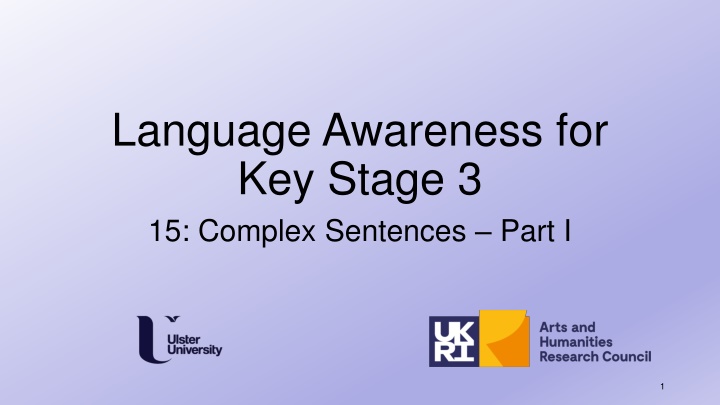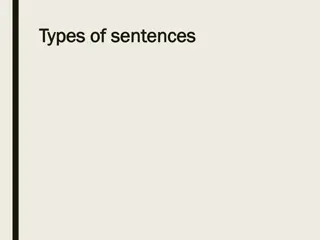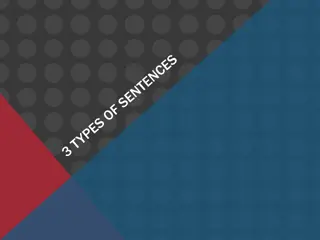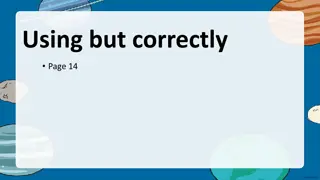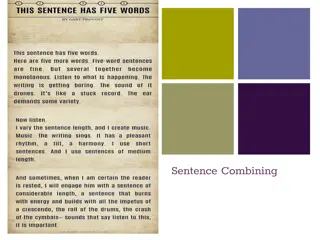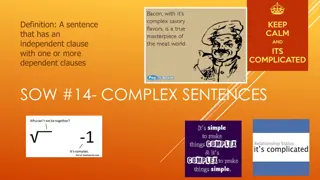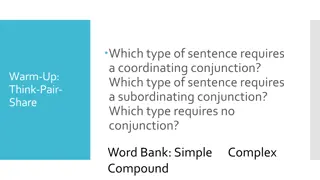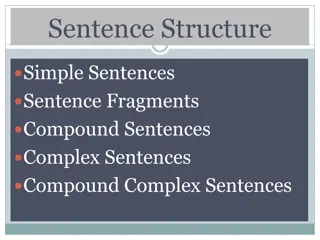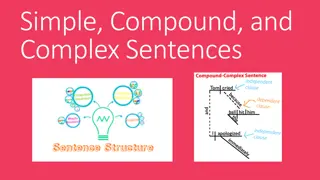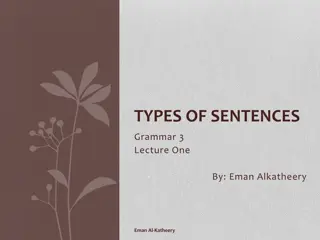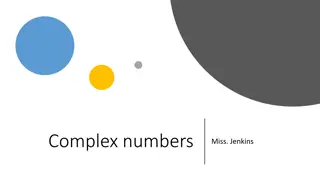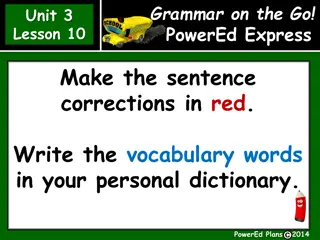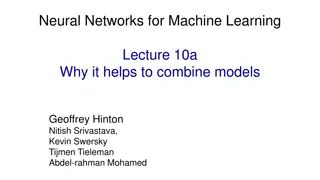Combining Simple Sentences into Complex Sentences
A detailed exploration of complex sentences, including main and subordinate clauses, relative pronouns, and types of relative clauses. Learn how to combine sentences effectively to enhance your writing. Dive into examples and understand the nuances of sentence structure.
Download Presentation

Please find below an Image/Link to download the presentation.
The content on the website is provided AS IS for your information and personal use only. It may not be sold, licensed, or shared on other websites without obtaining consent from the author.If you encounter any issues during the download, it is possible that the publisher has removed the file from their server.
You are allowed to download the files provided on this website for personal or commercial use, subject to the condition that they are used lawfully. All files are the property of their respective owners.
The content on the website is provided AS IS for your information and personal use only. It may not be sold, licensed, or shared on other websites without obtaining consent from the author.
E N D
Presentation Transcript
Language Awareness for Key Stage 3 15: Complex Sentences Part I 1
Roadmap Today we will look at ways to combine simple sentences into a single, complex sentence We will revisit forms that we have seen before, such as relative pronouns, complementizers, and other conjunctions We will see how these forms allow sentences to be used in the same way as other parts of speech: adjectives, nouns, and adverbs We will also see how complex sentences can include indirect questions 2
Complex Sentences A complex sentence is a sentence with one or more other sentences inside it The outer part is the main clause (sometimes called the root or matrix clause) The inner parts are subordinate clauses (sometimes called secondary or embedded clauses) The subordinate clauses add something extra to the main sentence: A modifier for a noun A subject or object for a verb An adverbial modifier We will see examples of each of these types, one by one 3
Relative Pronouns One way to combine sentences is using relative pronouns 1. I saw a bird 2. You saw a bird 3. You saw the bird that I saw The part of a complex sentence that depends on a relative pronoun is called a relative clause 4
Relative Pronouns Relative clauses often perform a function similar to adjectives, helping to modify, define or describe people and things 3. You saw the bird that I saw 4. You saw the same bird 5
Relative Pronouns Relative clauses are often divided into two types, restrictive and non-restrictive Restrictive clauses are used to define something 5. Mary found the dog that was lost All we know about the dog is that it is the one that was lost Non-restrictive clauses describe something already known 6. Mary found John s dog, which was lost John s dog tells us which dog it was, and the relative clause just tells us something extra about it 6
Relative Pronouns In English, the rule of thumb is that that is used for restrictive clauses and who/which for non-restrictive clauses But the full details of when each form is used are much more complex However, many languages always use the same word for each type of clause, as in French 7. Marie a trouv le chien qui tait perdu Mary has found the dog that was lost 8. Marie a trouv son chien, qui tait perdu Mary has found his dog, which was lost You can still tell the two types apart by their meaning, and usually by the comma before non-restrictive clauses (or a pause in speech) 7
Relative Pronouns Like other pronouns, relative pronouns can have gender 9. Mary found John s son, who was lost 10.Mary found John s aunt, who was lost 11.Mary found John s wallet, which was lost Who in (9) is masculine Who in (10) is feminine Which is neuter 8
Relative Pronouns Relative pronouns can also have case 12.Mary spoke to John, who had lost his wallet 13.Mary spoke to John, whose wallet was lost 14.Mary spoke to John, whom she had just met In (12), who is nominative it is the subject of had lost In (13), whose is possessive (genitive) In (14), whom is accusative it is the object of had met Sometimes people also use who as an accusative form That always has the same form for all genders and cases 9
Relative Pronouns We see the same patterns in other languages where pronouns show gender and case, such as German 15. Maria sprach mit Hans, der seine Brieftasche verloren hatte Mary spoke with John, who had lost his wallet 16. Maria sprach mit Hans, dessen Breiftasche verloren war Mary spoke with John, whose wallet was lost 17. Maria sprach mit Hans, dem sie gerade begegnet war Mary spoke with John, whom she had just met 18. Hans sprach mit Maria, die ihre Brieftasche verloren hatte John spoke with Mary, who had lost her wallet 19. Hans sprach mit Maria, deren Brieftasche verloren war John spoke with Mary, whose wallet was lost 20. Hans sprach mit Maria, der er gerade begegnet war John spoke with Mary, whom he had just met 10
Activity Take a minute to look at these examples. What do you notice about German word order? Do you notice any other differences between German and English? 15. Maria sprach mit Hans, der seine Brieftasche verloren hatte Mary spoke with John, who had lost his wallet 16. Maria sprach mit Hans, dessen Breiftasche verloren war Mary spoke with John, whose wallet was lost 17. Maria sprach mit Hans, dem sie gerade begegnet war Mary spoke with John, whom she had just met 18. Hans sprach mit Maria, die ihre Brieftasche verloren hatte John spoke with Mary, who had lost her wallet 19. Hans sprach mit Maria, deren Brieftasche verloren war John spoke with Mary, whose wallet was lost 20. Hans sprach mit Maria, der er gerade begegnet war John spoke with Mary, whom he had just met 11
Relative Adverbs There are also relative adverbs, which are very similar to relative pronouns 21.the place where something happened 22.the time when something happened 12
Complementizers Complementizers are another type of word that you may remember One use for complementizers is to let sentences be used as subjects or objects, in the same way as nouns 23.John has left 24.That John has left surprises me 25.This fact surprises me 26.Whether John has left or not is unimportant 27.This question is unimportant 13
Complementizers Because complementizers let sentences be used as subjects or objects, they can be used to form indirect questions and indirect statements 28.John has left 29.I wonder whether John has left 30.Mary says that John has left We will look more closely at indirect statements in the next lesson Note that that can be either a complementizer or a relative pronoun If it is a relative pronoun, it will be modifying a noun If it is a complementizer, it will normally be the subject or object of a verb 14
Indirect Questions Another way to form indirect questions is using interrogative pronouns Interrogative pronouns are the ones used in questions 31.Who did that? 32.John asked who did that 15
Indirect Questions Another way to form indirect questions is using interrogative pronouns Interrogative pronouns are the ones used in questions 31.Who did that? 32.John asked who did that Can you describe the difference between questions beginning John asked who and John asked whether ? 16
Indirect Questions In English, interrogative pronouns often look like relative pronouns 33.I saw who did it 34.I saw the person who did it This is true in many other languages, such as French 35.J ai vu qui l a fait 36.J ai vu la personne qui l a fait 17
Indirect Questions However, there are also languages where interrogative pronouns and relative pronouns have different forms 37.Ich habe gesehen, wer es gemacht hat I saw who did it 38.Ich habe gesehen den Menschen, der es gemacht hat I saw the person who did it 39.E don t s epo sen aut I saw who did it 40.E don t n nthr pon h s epo sen aut I saw the person who did it (German) (Greek) 18
Subordinating Conjunctions As you may remember, there are many conjunctions that can be used to combine sentences These conjunctions modify the meaning of the sentence in some of the same ways as adverbs 41.John left 42.Something happened after John left 43.Something happened then 44.Something happened although John left 45.Something happened anyway 19
Subordinating Conjunctions One important conjunction is if, which is used in conditional sentences 46.If John left, someone should bring him back If can also be used as a complementizer, likewhether 47.I asked if John left As a complementizer, if creates a clause that can be used as the object of a verb (ask) Note that a sentence like (47) does not have a conditional meaning ( If John left, then in that case I asked ) 20
Activity Take some time and try to make a list of all the other subordinating conjunctions you can find Do not include coordinating conjunctions (and, or, but, etc.) If you re not sure whether a word is right or not, you can consult a dictionary 21
Subordinating Conjunctions You may remember the difference between coordinating conjunctions and subordinating conjunctions from an earlier lesson Coordinating conjunctions join two equal sentences to form a single compound sentence 48.John left and something happened and left happened 22
Subordinating Conjunctions Subordinating conjunctions subordinate one sentence to another and form a single complex sentence 49.John left before something happened left before happened 23
Subordinating Conjunctions The relationships expressed by coordinating conjunctions are more likely to be symmetrical This means that you can reverse the order without changing the meaning 50.John is Irish and Christina is Greek 51.Christina is Greek and John is Irish 24
Subordinating Conjunctions The relationships expressed by coordinating conjunctions are more likely to be symmetrical This means that you can reverse the order without changing the meaning 50.John is Irish and Christina is Greek 51.Christina is Greek and John is Irish Can you think of any sentences with a coordinating conjunction that are not symmetrical? Can you think of any sentences with a subordinating conjunction that are symmetrical? 25
Conclusion We have seen many different ways of combining simple sentences into a single, complex sentence We have looked at relative pronouns, complementizers, and various conjunctions We have seen different ways of forming indirect questions We have also looked at the difference between subordination and coordination 26
